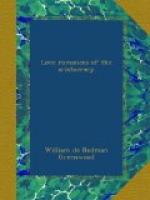Indeed, Crosby Hall, ever since the worthy alderman, whose name it bore, had raised its walls late in the fifteenth century, had been the most stately mansion in the city, and had had a succession of famous tenants. When Sir John Crosby left it for his splendid tomb in the Church of St Helen’s, it was for a time the palace of Richard, Duke of Gloucester, in which, to quote Sir Thomas More, “he lodged himself, and little by little all folks drew unto him, so that the Protector’s Court was crowded and King Henry’s left desolate”; and it was in one of its magnificent rooms that Richard was offered, and was pleased to accept, the Crown of England.
Shakespeare, who lived in St Helen’s in 1598, knew Crosby Hall well, and has immortalised it in “Richard III.”; Queen Elizabeth was feasted more than once within its hospitable walls, and trod more than one measure there with Raleigh. For seven years it was the home of Sir Thomas More when he was Treasurer of the Exchequer; and, to his friend and successor as tenant, More sent that affecting farewell letter, written in the Tower with a piece of charcoal, the night before his execution. Such was the historic and splendid home in which “Rich Spencer” dispensed hospitality as Lord Mayor of London in the year 1594.
Not content with the lordliest mansion in London Sir John must also have his house in the country, to which he could repair for periods of leisure and rest from his money-making; and this he found in Canonbury Tower, which he purchased, together with the manor, from Lord Wentworth. It is said that Sir John had a bargain in his purchase; but, in the event, he narrowly escaped paying for it with his life. It seems that the news of “Rich Spencer’s” wealth had travelled as far as the Continent, and there tempted the cupidity of a notorious Dunkirk pirate, who conceived the bold idea of kidnapping the merchant and holding him to a heavy ransom. How the attempt was made, and how providentially it failed is told by Papillon.
“Rich men,” says this chronicler, “are commonly the prey of thieves; for where store of gold and silver is, there spirits never leave haunting, for wheresoever the carcass is, there will eagles be gathered together. In Queen Elizabeth’s days, a pirate of Dunkirk laid a plot with twelve of his mates to carry away Sir John Spencer, which, if he had done, L50,000 ransom had not redeemed him. He came over the sea in a shallop with twelve musketeers, and in the night came into Barking Creek, and left the shallop in the custody of six of his men; and with the other six came as far as Islington, and there hid themselves in ditches near the path in which Sir John came always to his house. But by the providence of God—I have this from a private record—Sir John, upon some extraordinary occasion, was forced to stay in London that night; otherwise they had taken him away; and they, fearing they should be discovered, in the night-time came to their shallop, and




